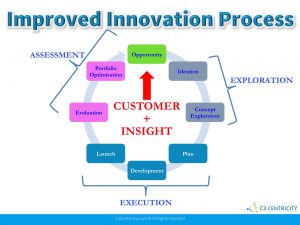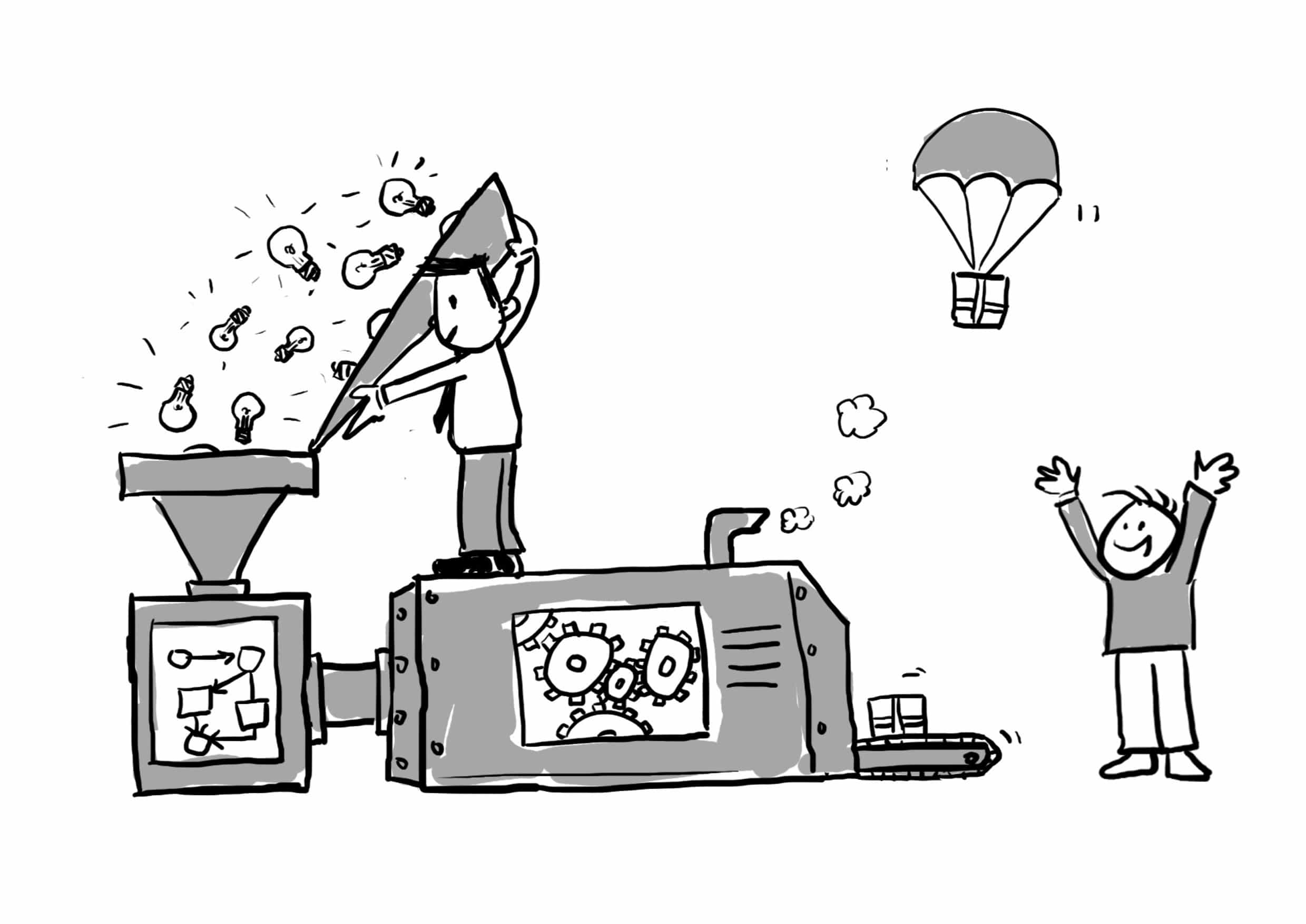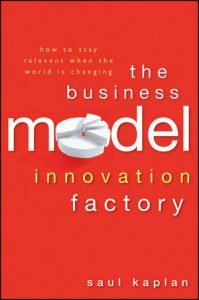I’ve written a number of posts on innovation and yet I still get client requests to further help them innovate successfully!
One of the favourite articles here on C3Centricity about the topic is “Improving Ideation, Insight & Innovation: How to Prevent Further Costly Failures.”
Despite all the great ideas and tips it includes, I believe there is still more I can share. That’s why I am adding to last week’s post on marketing in general, with a post specifically about improving your innovation. In particular, I wanted to help those of you who may be unable to complete all the “best-practice” actions I recommend, through a lack of resources, be it time, money or people.
Not every organisation has access to large market research or marketing departments and extensive budgets. In fact, in many companies these roles are being handled by one and the same person with very few resources; is that your case? If so then you will definitely find this post of interest. But even if you’re one of the luckier ones with a good size team and plentiful budget, I’m sure you will still find value from the ideas shared.
Let’s start by taking a look at some of the reasons why new products fail. And then we’ll identify some creative ways to completely eliminate them from your next launch. Sounds good? Then read on.
Why your innovations fail
Did you know that the proportion of product launches which fail every year is generally “guesstimated” to be somewhere between 74% and 95%?
Why CEOs accept such abysmal levels and accept their organisations’ continued use of the same old innovation process is beyond me!
In this article in HBR, Saul Kaplan, author of “The Business Model Innovation Factory” shared five important reasons that explain why companies fail at business model innovation:
- CEOs don’t really want a new business model.
- Product is king. Nothing else matters.
- Cannibalization is off the table.
- ROI hurdles are too aggressive for fledgeling models.
- Rogues and renegades get no respect.
I find these five reasons spot-on. They are all based on fear of getting outside the organisation’s comfort zone. If you can identify yourself with even one of these, it might explain why your innovations are not as successful as you would like them to be.
Successful innovation involves change, and human beings don’t like being out of their comfort zone. It may involve challenging accepted ideas and ways of working too. No wonder so many innovations fail.
And with such odds, I think it is incredibly courageous to start a whole company based around just one new product idea, but that seems to be the norm for startups in many areas today.
Taking the organisational reasons mentioned above, I’d like to detail ten more ideas I have found in my work with clients as to why innovations fail:
#1 The process itself: Innovation is by definition a creative process, but many organisations use a well-worn, restrictive and uncreative process to develop their new products. As David Gluckman says:
“Committees are the death of innovation.”
As mentioned earlier, we don’t like things that shake up our comfortable beliefs and actions. Committees are unlikely to come up with groundbreaking innovations, just because they’re a group. In such teams, you tend to go with the least disruptive idea that everyone can accept.
#2 Meeting company quotas: It is surprising that with such miserable success rates, so many companies – and which shockingly include many of the largest CPGs around – continue to fix quotas on the number of annual new product launches.
How crazy is that?! It just encourages too many new products to be launched too early, and almost guarantees their failure!
#3 Lack of customer understanding: This is most likely one of, if not the most important reason for new product launch failures. And I don’t mean that you should ask the customer what he wants; he doesn’t know until you make it available to him in many industries. Successful innovators know their target customers better than they know themselves!
#4 Lack of category understanding: This follows on from customer understanding, in that you need to identify how the customer is currently working around or compensating for their need today. Don’t assume you are competing in a certain category until you have identified what the customer is currently doing or using. That is the way to identify your true competitors.
#5 Not living up to your promises: If you promise a better, cheaper or more enjoyable experience, then customers deserve to be able to confirm this when they buy. Especially in today’s connected world, if you disappoint by not meeting customers’ expectations, your product will fail even more quickly than in the past. Early-adopters will Tweet or leave comments on Facebook, Blogs or other social media platforms for all to see.
#6 Not being sufficiently differentiated: Following on from living up to your promises, customers need a reason to change their behaviours. Depending upon the category this can be costly, whether in time, money or effort.
Many customers prefer to continue buying an inferior product or service than making the effort to change. Just think about industries such as Telecom, Banking, Hotels, Air travel or Insurance. These businesses are in a constant battle to differentiate themselves and provide a real advantage to attract new customers. Luckily for them, at least until recently, the effort of leaving was perceived as greater than the pain of staying.
#7 Being too different: Whilst not being sufficiently differentiated can be a certain cause of failure, being too new can also meet with no success. The reason for this is that if customers are totally unfamiliar with the new product or service offering, you will need to spend considerable resources to educate them.
If you are unable or unwilling to invest the time and money in doing this, then you will undoubtedly fail. Attracting more than just a few customers who are willing to spend time understanding what you are offering takes resources.
#8 Pricing yourself out of the market: I’m not just speaking about pricing your product too high; being too low can also negatively impact your likely success. Part of a customer’s perceived value of a new product, especially before buying, comes from the price and expected usefulness to them of the promise you make.
Part of a customer’s perceived value of a new product, especially before buying, comes from the price and expected usefulness to them of the promise you make.
#9 Inappropriate distribution: This can be the consequence of an incomplete understanding of your customer and is also linked to differentiation. Whilst you can just follow near competitors into their own distribution channels, why ignore the possibility of being available exactly where and when your customers might just be ready to buy it the most?
#10 Being too far ahead of the customer: There are many examples of great products that were ahead of their time. Gillette brought out 2–in–1 shampoos with conditioner and shampoo combined in the early 70’s. They were a dramatic flop! Ten years later most personal care manufacturers offered these products and were met with huge success.
Following trends is a great way to understand how your customers are changing, but you need to also understand their speed of change to get your timing right.
It took Nespresso almost twenty years to become profitable for Nestle and Philip Morris has needed similar levels of patience in certain markets, before their most infamous of brands, namely Marlboro, took off.
How to innovate successfully
The ten reasons for innovation failure which I have mentioned, each have a number of solutions which you can use. Here are some ideas to get you thinking:

#1 The process: Introduce some creativity into the process. Use a virtuous circle as shown on the right, rather than the usual linear or funnel approach.
All innovation processes should start with a deep understanding of the potential customer segment and then insight development.
#2 Meeting company quotas: Instead of company quotas on the number or proportion of new product launches, a better target is a percentage of sales. This should eliminate all but the very best ideas, which are expected to increase sales rather than merely replace current products.
I also believe that it would be much better to seriously limit the acceptance level of new product ideas proposed in any year. This would be a case for quality over quantity and only the very best would get through the approval process.
This would also mean that brand managers would have to be assessed on sales performance and growth, rather than on the number of new products they launch.
#3 Lack of customer understanding: Steve Jobs is often quoted as saying
“People don’t know what they want until you show it to them.”
The best way to innovate successfully is to start by looking at the target customer’s lifestyle and seeing how you can make it easier and more enjoyable for them. If you already have a new product idea, then consider how it would make the customer’s life better. If it doesn’t, then you perhaps need to reassess its market appeal as it’s probably just a renovation.
Watching and listening to your customers with an open mind, rather than with your hypotheses in your head, will also enable you to identify pain points. The customer may even be unaware that they are compensating for something that they would change. What an incredibly valuable opportunity to offer a solution to them.
#4 Lack of category understanding: Never assume you are competing in a certain category until you have identified how your customers are choosing and what they are currently using. That is the way to identify your true competition.
I suggest using either a zooming in or zooming out technique from the current category, which I explain in our “I3 – Improved Ideation & Innovation” 1-Day Catalyst training sessions.
#5 Not living up to your promises: In today’s connected world, false or exaggerated promises are quickly identified and shared on social media. However, speaking about possible pain points you have identified and sharing your solution, will avoid your having to make any such misleading claims.
#6 Not being sufficiently differentiated: With such an abundance of information available to everyone, comparisons are easy to make. In fact, there are many websites which make a good living out of doing just that and then sharing their results.
Categories with little differentiation rapidly see that competing becomes largely price based. As a result, the products quickly become mere commodities. Better therefore to understand the category in which you are competing and its customers, so you can offer a point of differentiation. Solution-based offers will always be able to charge more than product-based ones. It’s up to you to decide which you want to do.
Solution-based offers will always be able to charge more than product-based ones. It’s up to you to decide which you want to be.
#7 Being too different: There are many startups today which offer only a few products or services. The successful ones have identified one or more pain points which the “big guys” have not, and take full advantage of them. In this case, their being different is a plus, because they offer the customer a solution.
However, for most brands, their problem is not being different enough, as mentioned above. It takes more than a new colour, aroma or packaging to be perceived as positively better than others. Identifying a sub-category of users with a precise need and then meeting that need better than anyone else is the more successful way to differentiate.
#8 Pricing yourself out of the market: Understand how much potential customers value your offer is essential to the success of any product. Getting it wrong can result in lost revenue or worse a promotional spiral leading to brand hell or commoditization. (read more about this in “Are you on the way to brand heaven or hell“)
#9 Inappropriate distribution: Appropriate distribution means being available where and when your customer is ready to buy. It also means reducing the effort needed for them to change their habits and buy your new offer. Trial will only come if you make it easy for customers to purchase.
This doesn’t mean being in stock everywhere at the lowest price. But it does mean being in the retail outlets that your target customers visit more often. Forget the exaggerated 100% distribution claims you used to get your new product line approaved; be selective in where you distribute, to attract your target customers first. The other customers will be your second priority as you get wider availability.
#10 Being too far ahead of the customer: If you can’t afford to wait for your customers to catch up with your new product or service idea, then you should certainly reconsider your launch decision. Keep the concept in your “back drawer” and follow the societal changes of your customers, so you will be ready when they are.
Most organisations are working on multiple new concepts at the same time, each at a different level of preparedness. Trend following will allow you to identify when the customer is ready for each offer. This will avoid too early, as well as tardy launches.
Identifying relevant trends to follow will also enable you to plan a multi-national roll-out in a more solid foundation than mere geography.
These are ten of the most common reasons for new product launch failure and a few ideas on how to resolve each of them. Which do you think is most prevalent in your business?
What are you going to change to increase the success of your future new product launches? Is it some other reason altogether, that I’ve missed? Let me know and share your thoughts below.
I will be sharing more tips on innovation excellence in future blog posts, but in the meantime feel free to send me any questions you still have. I’m always ready to have a short Skype or phone call to assist you with your own brand building challenges.
If you enjoyed reading this article, please recommend and share it, to help others find it! Thanks.
C3Centricity used images from Wiley, C3Centricity online and the book “Winning Customer Centricity” in this post; it has been updated from the original article first published in 2014.












